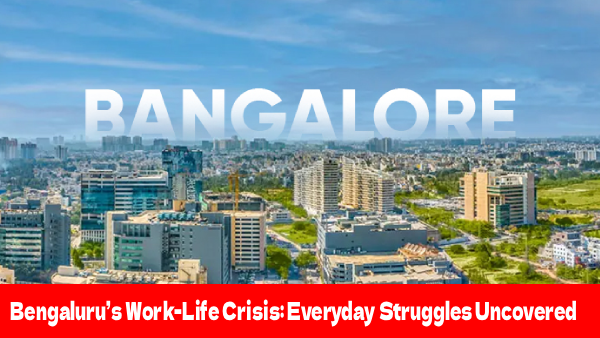Bengaluru’s Work-Life Crisis: Everyday Struggles Uncovered Amid Traffic Chaos & Crumbling Infrastructure
Bengaluru’s Work-Life Crisis: Everyday Struggles Uncovered as India’s Silicon Valley grapples with crippling traffic, crumbling roads, and shrinking work-life balance. Once celebrated as a garden city and global tech magnet, the metropolis is now battling infrastructure decay, hours-long commutes, and growing frustration among its workforce and industry leaders.
Bengaluru’s Work-Life Crisis: Everyday Struggles Uncovered in a City Losing Productivity
Bengaluru, home to nearly 12 million residents and some of the world’s leading tech giants—from Google to Microsoft—has reached a breaking point. The morning rush hour often stretches across half the workday, dramatically reducing productivity in India’s biggest innovation hub.
Entrepreneur RK Misra, co-founder of a multimillion-dollar startup, avoids morning meetings altogether due to unpredictable commutes. His 16-km journey sometimes takes two hours.
“It also discourages people from doing anything other than work, because there’s no work-life balance anymore,” he laments.
Bengaluru’s Work-Life Crisis: Everyday Struggles Uncovered on the Outer Ring Road
The city’s Outer Ring Road (ORR)—a 20-km corridor lined with Fortune 500 offices—hosts more than one million employees. Yet it’s riddled with potholes, chronic traffic jams, and monsoon floods.
In September, BlackBuck CEO Rajesh Yabaji announced moving his company out of ORR after commute times shot above 1.5 hours one way. Roads, he said, were “full of potholes and dust” with little effort toward repairs.
Adding to the concerns, Biocon founder Kiran Mazumdar-Shaw recounted an overseas visitor questioning the poor roads and garbage, asking if the government wanted to support investment at all.
Everyday Struggles Uncovered as Infrastructure Fails to Keep Pace
The TomTom Traffic Index ranked Bengaluru as the world’s third-slowest city in 2024, overtaking major global capitals. City officials acknowledge the crisis.
BS Prahallad from Bengaluru Smart Infrastructure Limited admitted that covering 16 km takes around 90–100 minutes on average.
Karnataka Deputy Chief Minister DK Shivakumar reported identifying over 10,000 potholes, with half already fixed. He urged the public to “build Bengaluru together,” emphasizing that the world sees India through the city.
Authorities now plan to split the municipal corporation into five smaller bodies under a Greater Bengaluru Authority, aiming to improve planning and governance—taking a cue from London.
From Garden City to Overburdened Metropolis
Once known as a serene retirement haven, Bengaluru’s transformation began in the 1990s with the IT boom. Since then, rapid expansion has:
-
Clogged waterways
-
Filled wetlands
-
Uprooted green spaces
-
Intensified flooding, droughts, and heatwaves
Environmental expert Harini Nagendra warns that residents are now “choking on pollution, concrete, and construction dust.”
Nearly half of Bengaluru depends on boreholes that run dry in summer, while the rest rely on water tankers—an issue worsening with climate change.
Despite Challenges, Hope Remains
Venture capitalist TV Mohandas Pai believes the city’s infrastructure is “three to five years behind,” but remains hopeful.
“The future is bright, but there is going to be pain. We are suffering the pangs of growth because India knows how to handle poverty, not prosperity.”












